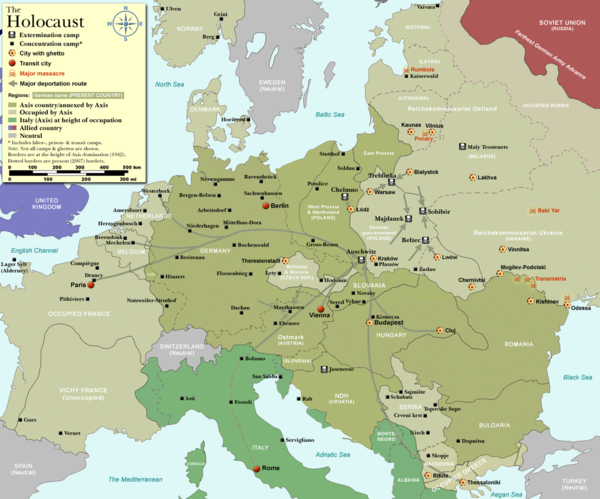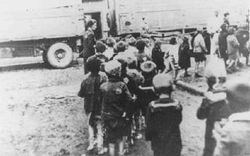Difference between revisions of "Nazi Ghettos"
| Line 20: | Line 20: | ||
==The killing == | ==The killing == | ||
Starting from 1942, the Nazis began the liquidation of the ghetto, first through mass shootings in the East, then with the establishment of death camps. Chelmno (Lodz), Treblinka (Warsaw and Bialystok), Sobibor, Belzec (Lvov), Majdanek, Auschwitz. The children and the elderly were the first to be eliminated. Orphanages and child hospitals in the ghettos were the first to be closed and all the residents killed or sent to extermination. | Starting from 1942, the Nazis began the liquidation of the ghetto, first through mass shootings in the East, then with the establishment of death camps. Chelmno (Lodz), Treblinka (Warsaw and Bialystok), Sobibor, Belzec (Lvov), Majdanek, Auschwitz. The children and the elderly were the first to be eliminated. Orphanages and child hospitals in the ghettos were the first to be closed and all the residents killed or sent to extermination. | ||
==== The orphans of Warsaw ==== | |||
In Warsaw the director of the orphanage, dott. Janusz Korczak (one of the most famous pedagogues of the 20th century), refused to abandon the children and marched with them to the train to Treblinka. No one survived. | |||
:''Janusz Korczak was marching, his head bent forward, holding the hand of a child, without a hat, a leather belt around his waist, and wearing high boots. A few nurses were followed by two hundred children, dressed in clean and meticulously cared for clothes, as they were being carried to the altar.'' (Ghetto eyewitness, Joshua Perle) | |||
:''He told the orphans they were going out into the country, so they ought to be cheerful. At last they would be able to exchange the horrible suffocating city walls for meadows of flowers, streams where they could bathe, woods full of berries and mushrooms. He told them to wear their best clothes, and so they came out into the yard, two by two, nicely dressed and in a happy mood. The little column was led by an SS man...'' ([[Władysław Szpilman]]) | |||
:''Dr. Janusz Korczak's children's home is empty now. A few days ago we all stood at the window and watched the Germans surround the houses. Rows of children, holding each other by their little hands, began to walk out of the doorway. There were tiny tots of two or three years among them, while the oldest ones were perhaps thirteen. Each child carried the little bundle in his hand.'' (Mary Berg) | |||
==== The children of the Lodz Ghetto ==== | |||
In September 1942 in the Lodz Ghetto virtually all children under 10 were sent to die in exchange for a stop in the extermination of the rest of the population. The head of the Judenrat, Rumkowski had to deliver a speech in which he asked parents to give away their children, arguing that the only chance for Jewish survival laid in the ability to work productively for the Reich without interference: | |||
:''A grievous blow has struck the ghetto. They [the Germans] are asking us to give up the best we possess – the children and the elderly. I was unworthy of having a child of my own, so I gave the best years of my life to children. I've lived and breathed with children, I never imagined I would be forced to deliver this sacrifice to the altar with my own hands. In my old age, I must stretch out my hands and beg: Brothers and sisters! Hand them over to me! Fathers and mothers: Give me your children!'' (Chaim Rumkowski, September 4, 1942) | |||
Around 13.000 children were sent to die. No one survived. | |||
[[File:Lodz Children.jpg|250px]] | |||
[[File:Lodz Children2.jpg|250px]] | |||
====The children of Bialystok ==== | |||
At the liquidation of the Bialystok Ghetto, all the 1200 surviving children were separated form their family and sent by train to Theresienstadt. There were rumors that they would be exchanged with German P.O.W. The negotiation did not succeed and after a few weeks, all children were sent to die at Auschwitz. They were all killed at their arrival. No one survived. | |||
Revision as of 17:26, 11 February 2020
Soon after the 1939 German invasion of Poland, the Nazis began to force Jews to live in designate areas, or ghettos.
Hundreds of ghettos were established. In most cases they functioned only as a temporary concentration of the local Jewish population before moving them to the major urban ghettos or directly to killing centers (designed areas in the woods or death camps). The major ghettos were those in Warsaw (500.000 people), Lodz, Krakow, Lvov, Bialystok, Lakhva in Poland; Kaunas and Vilnius in Lithuania; Budapest and Cluj in Hungary; Theresienstadt in Czechia.
Living conditions
Initially the ghettos were given some appearance of self-government under a Jewish Council and a Jewish police. Schools, hospitals and orphanages were organized for children.
The brutal living conditions in the ghettos, however, made soon vain any hope of a "normal" life. The Jews were not allowed out of the ghetto, so they had to rely on smuggling and the starvation rations supplied by the Nazis: in Warsaw this was 253 calories (1,060 kJ) per Jew, compared to 669 calories (2,800 kJ) per Pole and 2,613 calories (10,940 kJ) per German (the minimum recommended for an healthy life is 1,200). With the crowded living conditions, starvation diets, and insufficient sanitation (coupled with lack of medical supplies), epidemics of infectious disease became a major feature of ghetto life. before July 1942, 20% of residents died of 'natural' causes: some 43,800 in the Łódź Ghetto, 76,000 in the Warsaw Ghetto ...
The children and the elderly were the ones who suffered mostly from the brutal living conditions in the ghetto. Children died from starvation and diseases as well as lack of adequate clothing and shelter.
In spite of their acute vulnerability, children discovered ways to survive. Children smuggled food and medicine into the ghettos, in turn smuggling out their own personal possessions to trade for said goods. Children in youth movements later escaped the ghettos to join underground resistance activities such as Soviet partisan units; and lived as street children or in hiding, hosted to non-Jewish families.
In order to avoid deportation of the unemployed, many children tried to enroll as forced labor, as long as 12 hours a day.
The killing
Starting from 1942, the Nazis began the liquidation of the ghetto, first through mass shootings in the East, then with the establishment of death camps. Chelmno (Lodz), Treblinka (Warsaw and Bialystok), Sobibor, Belzec (Lvov), Majdanek, Auschwitz. The children and the elderly were the first to be eliminated. Orphanages and child hospitals in the ghettos were the first to be closed and all the residents killed or sent to extermination.
The orphans of Warsaw
In Warsaw the director of the orphanage, dott. Janusz Korczak (one of the most famous pedagogues of the 20th century), refused to abandon the children and marched with them to the train to Treblinka. No one survived.
- Janusz Korczak was marching, his head bent forward, holding the hand of a child, without a hat, a leather belt around his waist, and wearing high boots. A few nurses were followed by two hundred children, dressed in clean and meticulously cared for clothes, as they were being carried to the altar. (Ghetto eyewitness, Joshua Perle)
- He told the orphans they were going out into the country, so they ought to be cheerful. At last they would be able to exchange the horrible suffocating city walls for meadows of flowers, streams where they could bathe, woods full of berries and mushrooms. He told them to wear their best clothes, and so they came out into the yard, two by two, nicely dressed and in a happy mood. The little column was led by an SS man... (Władysław Szpilman)
- Dr. Janusz Korczak's children's home is empty now. A few days ago we all stood at the window and watched the Germans surround the houses. Rows of children, holding each other by their little hands, began to walk out of the doorway. There were tiny tots of two or three years among them, while the oldest ones were perhaps thirteen. Each child carried the little bundle in his hand. (Mary Berg)
The children of the Lodz Ghetto
In September 1942 in the Lodz Ghetto virtually all children under 10 were sent to die in exchange for a stop in the extermination of the rest of the population. The head of the Judenrat, Rumkowski had to deliver a speech in which he asked parents to give away their children, arguing that the only chance for Jewish survival laid in the ability to work productively for the Reich without interference:
- A grievous blow has struck the ghetto. They [the Germans] are asking us to give up the best we possess – the children and the elderly. I was unworthy of having a child of my own, so I gave the best years of my life to children. I've lived and breathed with children, I never imagined I would be forced to deliver this sacrifice to the altar with my own hands. In my old age, I must stretch out my hands and beg: Brothers and sisters! Hand them over to me! Fathers and mothers: Give me your children! (Chaim Rumkowski, September 4, 1942)
Around 13.000 children were sent to die. No one survived.
The children of Bialystok
At the liquidation of the Bialystok Ghetto, all the 1200 surviving children were separated form their family and sent by train to Theresienstadt. There were rumors that they would be exchanged with German P.O.W. The negotiation did not succeed and after a few weeks, all children were sent to die at Auschwitz. They were all killed at their arrival. No one survived.


